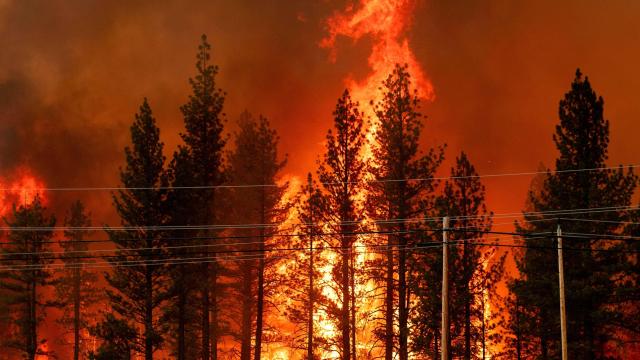The way plants sweat could be a valuable tool in helping us predict how wildfires behave. That’s the conclusion of a recent study published in Global Ecology and Biogeography from researchers at NASA’s Jet Propulsion Laboratory.
The temperatures of plants can tell us a lot about their health and the health of the ecosystems they live in. Under normal conditions, plants take in water through their roots and release it into the atmosphere through tiny pores in their leaves, a process known as evapotranspiration. But if the plants are under stress — especially if the weather is hotter and drier than usual — they’ll retain more water, which increases their temperature.
“It’s a similar mechanism to humans sweating to cool down,” explained Madeleine Pascolini-Campbell, a scientist at JPL and lead author of the study. “If plants aren’t able to release water, that ends up with them heating up.”
The study was possible thanks to an instrument attached to the International Space Station called ECOSTRESS — a cute moniker for ECOsystem and Spaceborne Thermal Radiometer Experiment on Space Station. “It’s basically a giant thermometer,” said Pascolini-Campbell. “It takes measurements of the temperature of the Earth’s surface, including plants.”
The ECOSTRESS instrument, which astronauts installed in 2018, is notable because of its specificity: It can take very high spatial resolution images “about the size of a soccer field,” Pascolini-Campbell noted, and passes over the same region of Earth once every couple of days, providing a lot of very specific data on plant temperatures over relatively short periods of time.
The NASA researchers wanted to see if the plants’ levels of evapotranspiration could correlate with areas burned in California’s 2020 wildfire season, a record-breaking summer that saw some 10,000 fires burn more than 4.3 million acres. They looked at data from six areas in Southern California and the Sierra Nevada mountains that were badly damaged in the 2020 season, comparing ECOSTRESS measurements from the months before the fires as well as satellite imagery taken after the fires.
Overall, the study found definite relationships between plant temperature and wildfire severity. In some regions, plants that were under more heat duress tended to be in areas with more intense burns. However, there were some important nuances in the data, given the diversity of the ecosystems at play.
“Some areas, such as pine forests in the Sierra Nevada, if they were more stressed, that corresponded to them having more severe burning. But in some other areas that had different types of land cover, such as grasslands, the less-stressed vegetation had higher burn,” Pascolini-Campbell said. The researchers hypothesised that in some ecosystems, like grasslands, less-stressed vegetation could actually grow more plentifully and ultimately provide more fuel for a fire. “We’re seeing these kinds of nuanced relationships that really depended on the type of vegetation present.”
As the West’s historic drought drags on and climate change makes wildfires even more intense and unpredictable, any data that can help predict fire patterns is invaluable. Pascolini-Campbell said she and her team hope to use ECOSTRESS data to study how plant sweat can foreshadow wildfire behaviour in other areas of the U.S., like Oregon.
“These kinds of datasets are really important and can potentially be used to predict fire severity for other regions, too,” she said.
